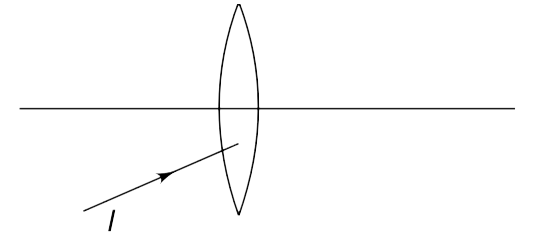Why does a convex lens converge the light rays?
Step-by-Step Solution:
1. Understanding the Convex Lens: A convex lens is a transparent optical device that is thicker in the middle than at the edges. It is designed to converge light rays that pass through it.
2. Drawing the Lens: Visualize or draw a convex lens with its principal axis. Label the center of the lens and the two curved surfaces.
3. Identifying the Focal Points: Mark the focal points on either side of the lens. The focal point is the point where parallel rays of light converge after passing through the lens.
4. Incoming Light Rays: Consider light rays coming from a distant object (essentially parallel rays). These rays are parallel to the principal axis of the lens.
5. Refraction at the Lens Surface: When these parallel rays hit the curved surface of the lens, they undergo refraction. Refraction is the bending of light as it passes from one medium to another (in this case, from air to glass).
6. Bending of Light Rays: As the rays pass through the lens, they bend towards the principal axis due to the curvature of the lens. The outer surface of the lens is curved outward, causing the rays to converge.
7. Convergence of Rays: After passing through the lens, all the refracted rays converge at a single point known as the focal point. This is the point where the light rays meet after refraction.
8. Conclusion: Therefore, a convex lens converges light rays because its shape causes incoming parallel rays to bend towards the focal point, resulting in the convergence of these rays at that point.
Topper's Solved these Questions
- REFRACTION OF LIGHT BOOK - CENGAGE PHYSICSCHAPTER - REFRACTION OF LIGHT EXERCISE - MANDATORY EXERCISE (EXERCISE SET II)
27 Videos
- REFRACTION OF LIGHT BOOK - CENGAGE PHYSICSCHAPTER - REFRACTION OF LIGHT EXERCISE - MANDATORY EXERCISE (EXERCISE SET III)
1 Videos
- REFRACTION OF LIGHT BOOK - CENGAGE PHYSICSCHAPTER - REFRACTION OF LIGHT EXERCISE - OLYMPIAD AND NSE LEVEL EXCERCISES
10 Videos
- OPTICAL INSTRUMENTS BOOK - CENGAGE PHYSICSCHAPTER - OPTICAL INSTRUMENTS EXERCISE - OLYMPLAD AND NTSE LEVEL EXERCISES
10 Videos
- SOURCES OF ELECTRIC CURRENTBOOK - CENGAGE PHYSICSCHAPTER - SOURCES OF ELECTRIC CURRENTEXERCISE - OLYMPIAD AND NTSE LEVEL EXERCISES
10 Videos
Similar Questions
Knowledge Check
Assertion: Large convex mirrors are used to concentrate sunlight to produce heat in solar :yes always cooker.
Reason: Concave mirrors converges the light rays falling on it.AIf both assertion and reason are true and reason is the correct explanation of assertion.BIf both assertion and reason are true but reason is not the correct explanation of assertion.CIf assertion is true but reason is false.DIf both assertion and reason are false.Which of the following statements is/are correct about a convex lens?
I. Convex lens is converging for light of all wavelengths.
II. For virtual object, the image is also virtual.
III. For real object, the image is always real.AI and IIBII and IIICI and IIIDonly IConsider the following statements.
Convex lens is converging for light for all wavelengths.
For virtual object, the image is also virtual.
Which of the following statements is/are correct?ABoth I and II are correctBBoth I and II are incorrectCI is correct and II is incorrectDII is incorrect and I is correct
A convex lens converges the rays of light falling on it.
View SolutionThe medium on both sides of a convex lens is same. A light ray (I) is incident on it as shown. Draw the path of the ray after it emerges from the lens. Write each step of your construction. The focal length of the lens is known.

View SolutionHow does focal length of a convex lens change if violet light is used instead of red light.
View Solutiona) With the help of a labelled diagram explain how a convex lens converges a beam of parallel light rays. Mark the principle axis, optical center, principal focus and focal length of the convex lens on the diagram.
b) State whether convex lens has a real focus or a virtual focus.
c) List some things that convex lens and concave mirror have in common.
View SolutionThe redius of curvature of the convex face of a plano-convex lens is 12cm and its refractive index is 1.5.
a. Find the focal length of this lens. The plane surface of the lens is now silvered.
b. At what distance form the lans will parallel rays incident on the convex face converge?
c. Sketch the ray diagram to locate the image, when a point object is places on the axis 20cm from the lens.
d. Calculate the image distance when the object is placed as in (c).
View Solution
